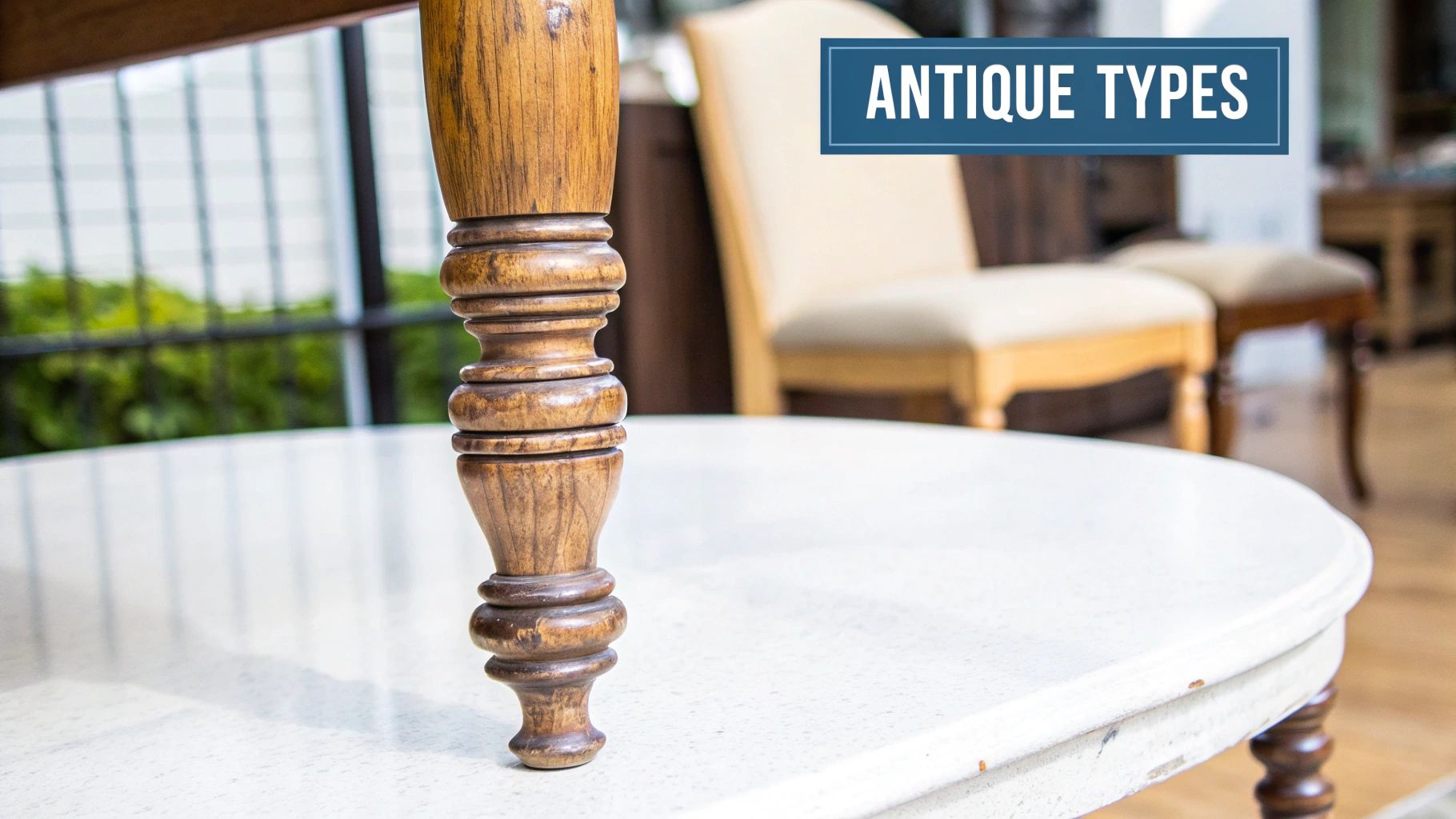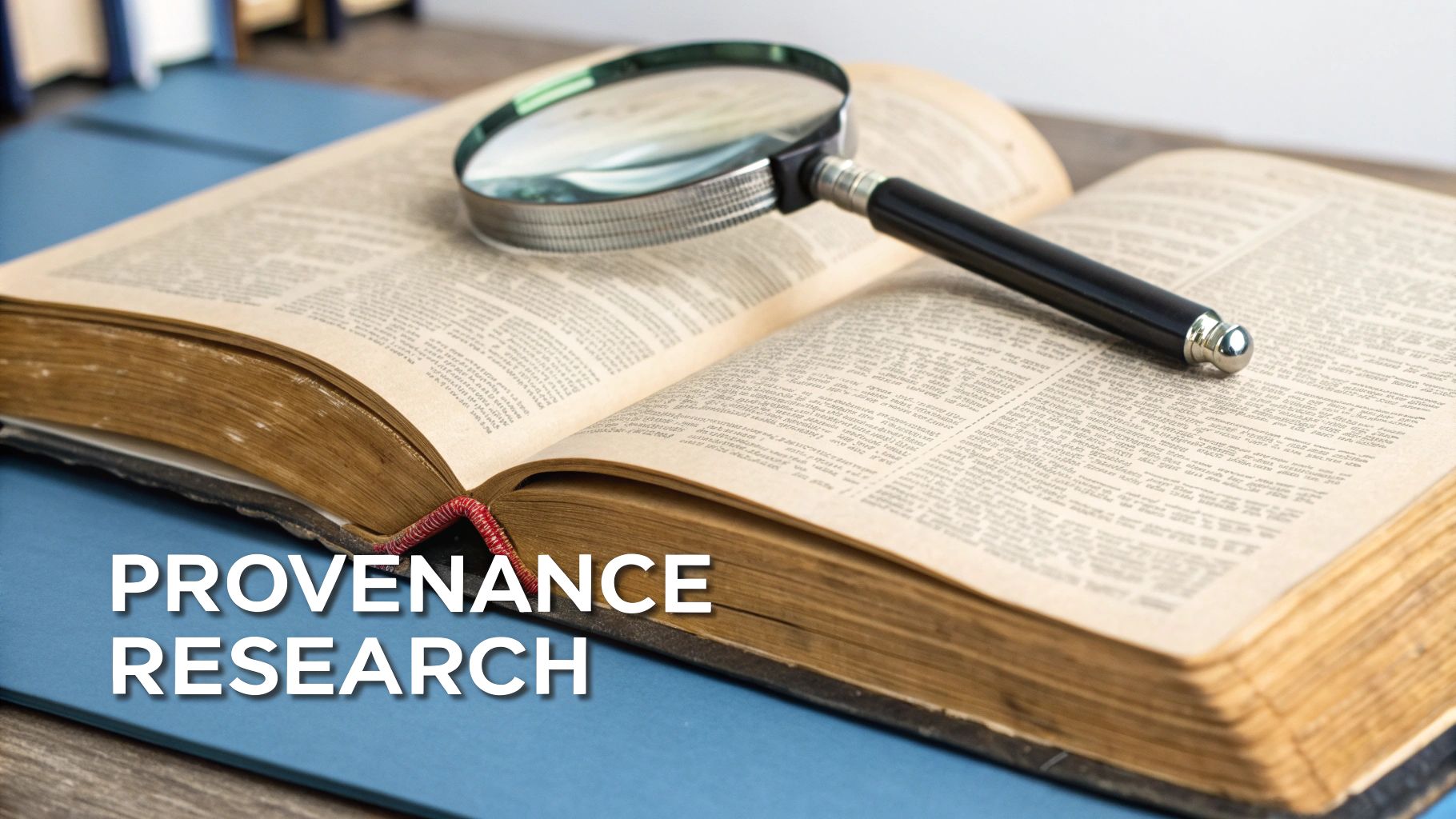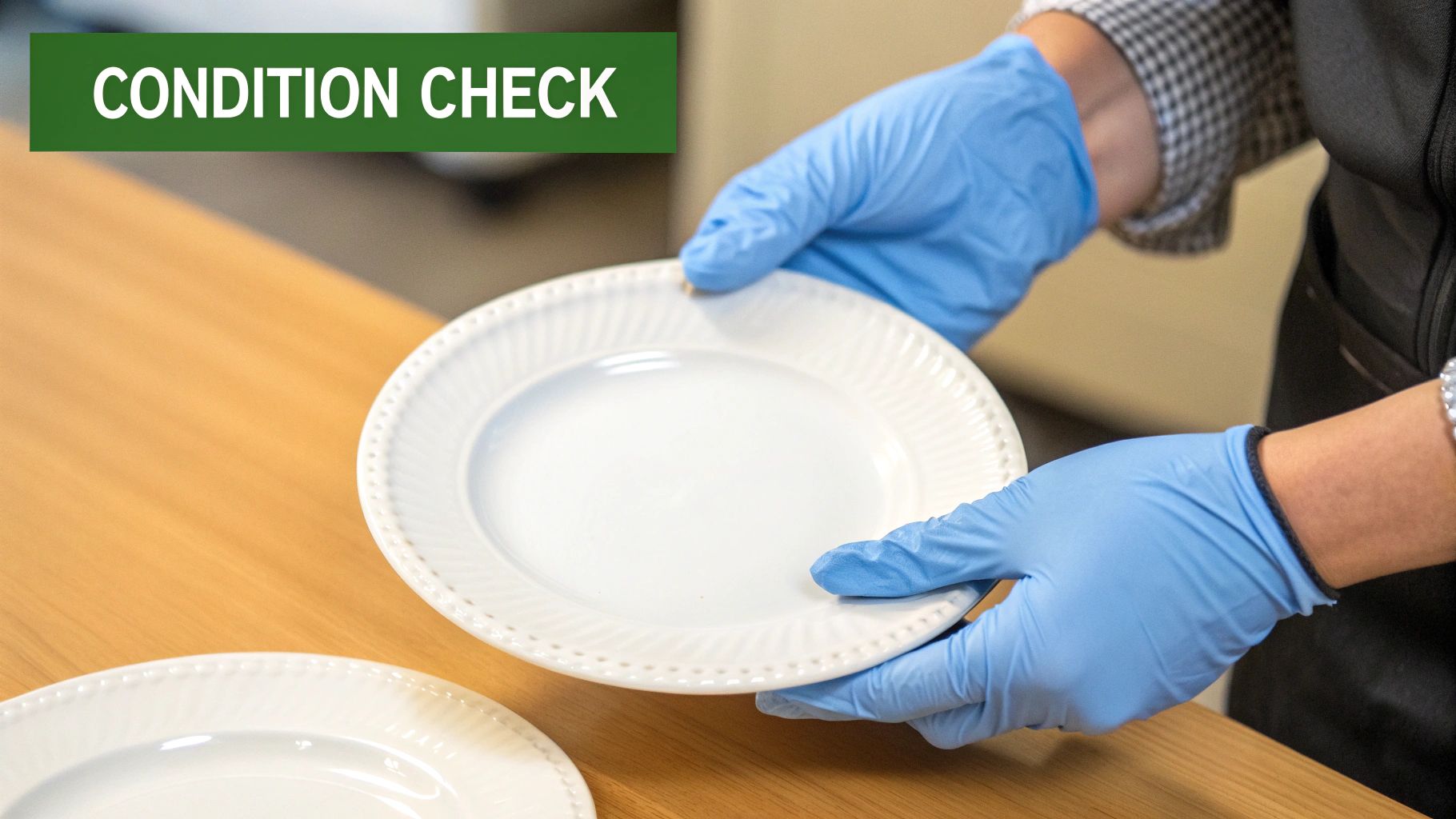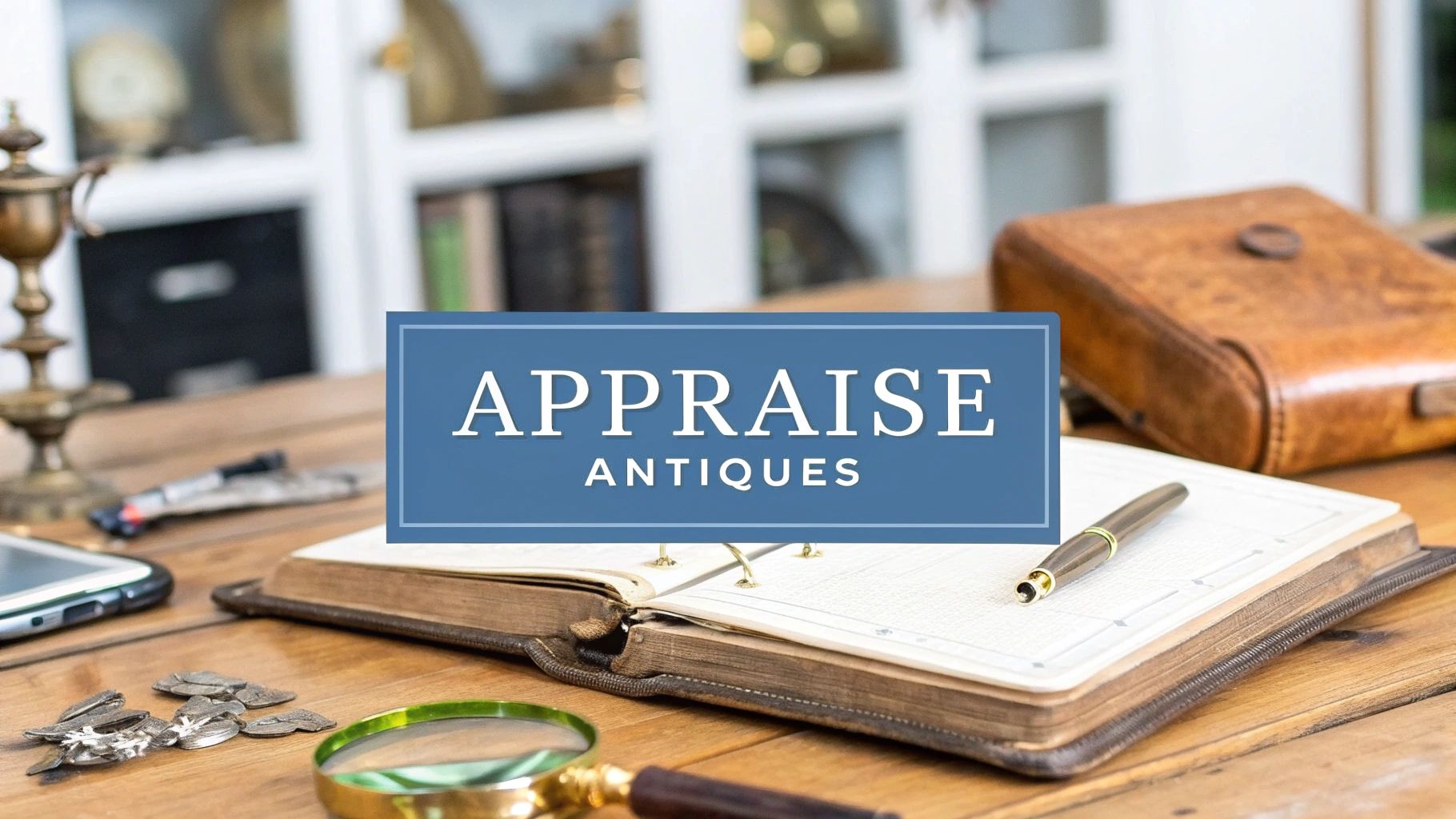Before you can even think about an antique's value, you need to get your hands on it and understand exactly what you're looking at. This first physical inspection is where you gather all the critical clues—the raw data that tells the item's story. Think of yourself as a detective dusting for fingerprints.
This initial check is the bedrock of your entire appraisal. It’s what helps you figure out an item's origin, age, and quality right from the get-go. If you rush this part, your final valuation will be built on sand.
Your First Look: Getting to Know the Piece
The clues you uncover in these first few minutes will guide all your later research. It’s the difference between a wild guess and an educated valuation.
Hunting for Signatures and Maker's Marks
Honestly, one of the most exciting parts of this job is finding a maker's mark, a signature, or a tiny hallmark. These little identifiers are your best shortcut to learning who made an item, where it came from, and often, exactly when.
Gently turn the piece over. Check its base, back, and any hidden spots. You'll want a magnifying glass and a good, bright light. Don't get discouraged if you don't find anything right away. Marks can be faint, worn down over time, or tucked away in the most unexpected places—like inside a drawer or along the inner rim of a vase.
Here are some of the usual hiding spots:
- Furniture: Look on the back, under the top, inside drawers, or for a surviving paper label.
- Ceramics & Glass: The bottom is your best bet. Marks can be stamped, incised (scratched into the clay), or painted on.
- Silver & Jewelry: Check the back or inside for tiny hallmarks that indicate purity (like "925" for sterling silver) or the maker's initials.
For example, finding a simple "Made in Occupied Japan" stamp instantly tells you the piece was made between 1945 and 1952. That single mark narrows your research dramatically and gives you a powerful piece of historical context.
Examining Construction and Craftsmanship
How something was made is just as telling as who made it. The construction techniques are a dead giveaway for an item's age and quality, helping you spot a genuine period piece from a later reproduction.
With furniture, the joints tell a story. Look at the dovetails in a drawer. Hand-cut dovetails, a hallmark of pre-industrial craftsmanship, are always slightly irregular and uneven. If you see perfectly uniform, precise joints, you're likely looking at a piece made with machines, which became common after about 1860.
Likewise, check for saw marks. Rough, straight saw marks that aren't perfectly parallel often point to an older, hand-sawn piece. The perfectly circular marks left by buzz saws didn't appear until the mid-19th century.
Assessing the Materials
Next, get a feel for the materials. Is that heavy chest of drawers solid oak, or is it a cheaper wood covered in a thin mahogany veneer? A solid wood plank will often show a continuous grain pattern from the top to the bottom edge. Veneer, on the other hand, might have peeling edges or bubbling, and you'll often see a different, less expensive wood on the underside.
For metalwork, the difference between sterling silver and silver plate is huge. Sterling is a solid silver alloy, making it much heavier and more valuable. Look for marks like "Sterling," "925," or a lion symbol. Silver-plated items are just a base metal with a thin silver coating—you can often spot wear and tear where the base metal is peeking through.
Once you’ve done this hands-on work, you're no longer just holding an old object. You have a set of solid clues—a maker's mark, a construction style, a specific material—that will steer your research and put you on the path to an accurate appraisal.
Getting a Feel for an Antique's Condition and Rarity

So, you've figured out the basics of what you're holding. Now comes the real test: evaluating its physical state. In this business, condition is king. A tiny chip, a hairline crack, or a sloppy repair can be the difference between a genuine treasure and just another decorative piece.
You have to go beyond a quick glance. Start training your eye to see what the pros see—the subtle clues that tell the real story of an item's life. We're talking about spotting old restorations, knowing the difference between honest wear and outright damage, and understanding how it all adds up in the final valuation.
Spotting Signs of Repair and Restoration
A professional restoration can sometimes save or even boost an item's value, but a clumsy repair job almost always sinks it. The trick is knowing what to look for, and believe me, many repairs are meant to be hidden. You have to play detective.
One of your best secret weapons is a simple black light (UV light). Under its glow, modern glues, fillers, and paints often light up in a way the original materials don't. This is a game-changer for ceramics. A repainted chip or a glued crack that’s invisible to the naked eye will often flare up instantly, giving the game away.
When it comes to furniture, check the hardware. Are the screws too shiny and uniform? Finding Phillips head screws on a piece you've been told is from the 18th century is a dead giveaway—they weren't common until the 1930s. It’s a huge red flag that something has been replaced or mucked with.
Differentiating Wear from Damage
Not all signs of age are a bad thing. In fact, a certain amount of wear and tear, what we call patina, is often a good thing. It adds character and proves an item is authentic and has a story to tell. Think of the gentle rounding on a chair's arm from a century of hands resting on it, or that soft glow on an old bronze statue. That's honest wear.
Damage, on the other hand, is a different beast entirely. It's any issue that hurts the item's structural integrity or visual appeal.
- Honest Wear (The Good Stuff): This includes faded upholstery from years in the sun, minor surface scratches on a tabletop, or the natural darkening of wood. These are the marks of a life well-lived.
- Significant Damage (The Bad Stuff): Look out for deep cracks in porcelain, missing parts like a clock's pendulum, big chips, or nasty water stains on wood. These problems will almost always drag the value down.
One of the biggest mistakes I see people make is "cleaning up" an old piece. They polish the beautiful tarnish off silver or slap a new coat of varnish on furniture. This can strip away decades of history and slash its value by 50% or more. Collectors want originality above all else.
Figuring Out an Item's Rarity
Once you have a handle on condition, you need to think about rarity. Is this thing one-of-a-kind, or did they crank out thousands of them? The answer dramatically changes its worth. Even a piece in mint condition won't be worth much if the market is flooded with identical ones.
Start with some digging online. Search for your item using the maker's mark, style, and materials you've already identified. How many similar pieces pop up on auction sites, dealer pages, or in museum archives? If you see dozens for sale, you probably have a common piece. But if you can only find one or two examples tucked away in a museum collection, you might be holding something special.
This is especially true in niche markets like antique jewelry. The global jewelry appraisal market is projected to grow by USD 1.81 billion between 2023 and 2028, largely because people are hunting for unique vintage finds. The value of an old ring isn't just in its gold and gems; it's in the unique craftsmanship, the historic design, and its scarcity. You can explore the full report on jewelry market trends to see just how much rarity drives value in that world.
Uncovering an Antique's History and Provenance

An antique's story, or its provenance, is what separates a beautiful object from a valuable piece of history. Think of it as an item's resume—a documented timeline of where it's been and who has owned it. A solid provenance can make an item's value skyrocket.
Imagine you have two identical 19th-century writing desks. One is completely anonymous. The other comes with a letter proving it once belonged to a famous author. That single piece of paper transforms the desk from mere furniture into a tangible connection to the past, making it infinitely more desirable to collectors. This is why appraising antiques means becoming part-historian, part-detective.
Starting Your Search for Documentation
The hunt for provenance always starts with whatever paperwork or stories came with the piece. This is the low-hanging fruit, and it’s often the most authentic proof you'll find. Your job is to gather anything that links the antique to a specific person, place, or period.
Begin by looking for physical clues that might have been tucked away with the item itself. Don't dismiss something just because it seems minor at first.
- Original Receipts: An old bill of sale is pure gold. It can lock in the date of purchase, the price paid, and who originally sold it.
- Family Letters or Diaries: Simple mentions like "father's new armchair" or "the silver set from our wedding" in dated letters can build a powerful, personal history.
- Old Photographs: A photo showing the antique in a family home decades ago is fantastic visual proof of its age and ownership history.
- Previous Appraisal Documents: Even if they're outdated, earlier appraisals add another chapter to the item's documented life.
These tangible pieces of evidence are your starting point. They give you the first threads you can pull on to weave together a complete history. If you're just starting, getting a firm handle on the basics of a piece is critical before you dig into its past. Our guide on how to identify antiques can give you a solid foundation for this first step.
Expanding Your Research Beyond the Obvious
So, what do you do when there's no shoebox full of old receipts? This is where your real detective work kicks in. It's time to turn to public records and digital archives to build your case, a process that the internet has made much easier.
Museum archives and historical societies often have digitized collections you can search right from your computer. If you know an original owner's name or where they lived, you might find your item listed in an old estate inventory or mentioned in local records. Auction house databases are another fantastic resource. Sites like Sotheby's and Christie's keep detailed records of past sales, which can help you trace an item's journey through the market.
Key Takeaway: Provenance isn't just about famous owners. A documented history showing an item was in the same family for 150 years, passed down through generations in a specific town, can also add significant value by confirming its age and authenticity.
Verifying Claims and Historical Context
Just because a story has been passed down doesn't make it true. A crucial part of this process is verifying every piece of information you uncover. If a seller claims a Civil War sword belonged to a specific general, you need to find hard evidence to back that up.
Look for consistency. Do the maker's marks on the sword match the supposed time period? Do historical records place that general in the location where the sword was found? Cross-referencing your findings is non-negotiable.
Understanding the bigger picture—the historical context—is also vital. Knowing an item was made during the Art Deco period (1920-1935) helps you understand its design, materials, and potential value. An Art Deco piece is defined by its bold geometric shapes and luxurious materials, reflecting the glamour of the Roaring Twenties. Recognizing these period-specific traits helps confirm an item’s age and authenticity, making your appraisal that much stronger.
Researching The Market Value For Your Antique

Alright, you've identified your piece, scrutinized its condition, and maybe even uncovered a bit of its story. Now for the million-dollar question—or maybe the fifty-dollar question: what's it actually worth? This is where we stop guessing and start digging into the data.
Your mission is to find "comparables"—often called "comps"—which are just records of similar items that have recently sold. This is probably the most crucial part of appraising anything yourself. An antique's value isn't based on what it cost a hundred years ago; it’s about what someone is willing to pay for it right now. Grounding your estimate in real-world sales is how you move from a hunch to a defensible price.
First, Know What "Value" You're Looking For
Before you even open a browser tab, you need to be clear on why you need a value. "Value" isn't a single, magical number. The figure you land on depends entirely on your goal, and getting this wrong can lead to some serious disappointment.
You'll generally run into three main types of valuation:
- Fair Market Value (FMV): This is the sweet spot—what a willing buyer pays a willing seller when neither is in a rush. It’s what you’re looking for if you plan to sell to another collector or list it online.
- Replacement Value: Think insurance. This is the retail price to buy a nearly identical replacement. It's almost always higher than FMV because it reflects what a dealer would charge.
- Liquidation Value: This is the "I need it gone yesterday" price. It's the lowest of the bunch and applies to quick sales, like an estate cleanout or a fast-paced auction where speed is more important than top dollar.
Knowing which number you need helps you filter your research and make sense of the prices you uncover.
Hunting Down Comparables Online
The internet has been a game-changer for finding sales records. The best sources are online databases that collect auction results from all over the world. These platforms show you what things actually sold for, which is far more useful than what sellers are just asking for.
When you're trying to pin down a price, you need solid data. Here's a look at some of the best online resources to find what your antiques have actually sold for.
Online Antique Research Platform Comparison
| Platform Name | Best For | Pricing Model | Key Feature |
|---|---|---|---|
| WorthPoint | Broad-range research across eBay, auctions, and more | Subscription | Massive database with over 20 years of sales data |
| LiveAuctioneers | Auction house sales, fine art, and high-end collectibles | Free to search sold items | Real-time and past auction results from 5,000+ auctioneers |
| Invaluable | Art, antiques, and collectibles from premier auction houses | Free to search sold items | Access to high-end auction results and upcoming sales |
| eBay (Sold Listings) | Everyday collectibles, vintage items, and common antiques | Free | Excellent for finding FMV on more accessible items |
Each of these platforms offers a different window into the market. For a quick check on common pottery or vintage toys, eBay's sold listings are fantastic. But for a rare piece of furniture or fine art, a deep dive into WorthPoint or LiveAuctioneers is essential.
When you start your search, be as specific as possible. Don't just type "old wooden chair." Instead, try something like "19th-century American Sheraton mahogany side chair." The more details you can plug in—maker, period, material, dimensions—the cleaner and more relevant your results will be.
Expert Tip: Always, always check the sale dates. The market for antiques can shift quickly. A price from six months ago is a solid data point; a price from six years ago is ancient history.
Making Sense Of Your Findings
Once you've collected a handful of good comps, it's time to connect the dots. Don't just take the average of the prices and call it a day. You need to figure out why one seemingly identical item sold for $500 while another only brought in $150.
Look closely at the details of each comparable sale and stack them up against your own item:
- Condition: Did the listing mention chips, cracks, repairs, or missing pieces? Even small flaws can dramatically reduce value.
- Provenance: Was there a juicy backstory? A documented history linking an item to a famous person or event can send its value soaring.
- Auction Venue: A piece sold at a world-renowned auction house like Christie's will often command a higher price than the exact same item on a local online marketplace.
- Listing Quality: Never underestimate the power of a good photo and a well-written description. Professional presentation often leads to higher bids.
By weighing these factors, you can realistically adjust your own item's expected value up or down from the comps you found. This thoughtful analysis is what turns raw data into a confident appraisal. For more on the nitty-gritty of what drives an antique's price, our guide on what your antiques are worth is a great next step.
When You Should Hire a Professional Appraiser

Doing your own research is a great skill to have, but let's be realistic—some situations just call for a pro. Knowing when to hand the reins over to a certified appraiser is crucial for protecting your assets and making smart, informed decisions.
A self-appraisal is perfectly fine for satisfying your own curiosity or slapping a price tag on something for a garage sale. But when the stakes are high, you absolutely need an official, written appraisal from a professional. It's simply not negotiable.
Critical Moments for a Certified Appraisal
Certain life events demand a valuation that will hold up under a microscope, especially a legal one. This is where a qualified appraiser provides a detailed, official report that serves as concrete documentation.
Think about calling in an expert for these key situations:
- Insurance Coverage: To properly insure a valuable piece, you need a formal appraisal that states its replacement value. If it's ever lost, stolen, or damaged, this report is the proof your insurance company will demand to process your claim.
- Estate Planning: When settling an estate or dividing assets, a certified appraisal ensures everything is fair and square. This unbiased valuation helps prevent family disputes and provides the necessary documentation for tax authorities.
- High-Value Sales: If you suspect you have a real treasure on your hands, an official appraisal gives your asking price legitimacy. It gives potential buyers the confidence to make an offer and gives you a solid footing for any negotiations.
A formal appraisal is far more than just a price tag. It's a legally defensible document that protects you, your family, and your investments by providing a clear, unbiased valuation right when you need it most.
How to Find and Vet a Qualified Appraiser
Finding the right expert is everything. You're not just looking for any appraiser; you need someone with deep knowledge in your specific item's category and the credentials to prove it.
A great place to start is with the major professional organizations. These groups have strict codes of ethics and require members to pass tough exams. The two most respected designations in the United States are:
- ASA (American Society of Appraisers): Members are tested experts in a wide range of fields, including antiques and decorative arts.
- ISA (International Society of Appraisers): This organization focuses specifically on educating and credentialing personal property appraisers.
Before you hire anyone, have a few questions ready to make sure they're the right fit. A good appraiser will be happy to talk about their process. Always ask about their experience with items like yours and get a written explanation of their fees. Their rate should be flat or hourly—never a percentage of the item’s value. For more guidance, our complete https://www.curio.app/blog/antique-appraisal-guide offers more questions to ask a potential appraiser.
The Professional Appraisal Process
Once you’ve found your appraiser, they'll typically want to conduct a thorough, in-person examination. This hands-on inspection allows them to see and feel the condition, craftsmanship, and materials in a way photos just can't capture. They’ll take detailed notes and photographs to support their research.
After the physical inspection, the real work begins. The appraiser will dig into current market data, looking for comparable sales to pinpoint an accurate value. This all comes together in a formal, written report detailing their findings, the item's description, its history, and, of course, its final appraised value.
This kind of documented, transparent valuation has become even more vital as the market has shifted online. The pandemic accelerated this change, with online art and antique sales rocketing to USD 12.4 billion in 2020—double the previous year. This digital boom, detailed in the latest art market research from UBS, means that trusted, verifiable appraisals are more critical than ever before.
Common Questions About Appraising Antiques
Even after you've done your homework, a few questions always seem to surface when you're trying to figure out an antique's value. It’s a process with a lot of moving parts, and getting straight answers to these common sticking points can save you from making a costly misstep.
Think of this as a quick chat with an expert. I've rounded up the questions I hear most often and broken them down with simple, practical answers to help you navigate your next appraisal with confidence.
How Much Does a Professional Appraisal Cost?
This is usually the first thing people want to know, and the honest answer is, it depends. Professional appraisers have a few standard ways of charging for their time, but there’s one giant red flag you absolutely must avoid.
A credible appraiser will never charge a percentage of your item's value. That's a huge conflict of interest—it gives them a financial incentive to tell you your piece is worth more than it really is.
Instead, you should expect a fee structure that looks something like this:
- Hourly Rate: This is the most common setup. Rates typically run from $150 to over $400 per hour, based on the appraiser's specialty, reputation, and where they're located.
- Flat Fee: If you have a single item or a small, well-defined group of pieces, an appraiser might just give you a single price for the whole job.
- Day Rate: For larger projects, like an entire estate or a big collection that will take a full day or more, a day rate is standard practice.
Before you agree to anything, always get a written quote that clearly spells out all the fees. Good communication from the start protects both you and the appraiser.
What Is the Difference Between an Appraisal and an Estimate?
People use these terms interchangeably all the time, but in the world of antiques, they are miles apart. Knowing the difference is critical, especially if you need a valuation for insurance or legal reasons.
An estimate is really just an educated guess. It's often verbal, informal, and based on a quick look. An auction house might offer a free estimate to see if they want to sell your item, but it has no legal standing.
An appraisal, on the other hand, is a formal, legally binding document. It’s prepared by a qualified professional for a specific purpose, like getting an insurance policy or settling an estate. It requires in-depth research, a thorough examination, and a detailed written report.
Can I Get an Accurate Antique Appraisal Online?
Online appraisals can be a great starting point. They're quick, convenient, and perfect for satisfying your curiosity or getting a general idea of what a lower-value find might be worth.
But when the stakes are high—for a valuable piece or any official purpose—nothing beats an in-person inspection. It’s simply non-negotiable.
A hands-on examination allows an appraiser to see things a camera never will: the subtle tool marks, the true texture of the materials, the weight and balance of an object. They can spot tiny repairs or signs of wear that are completely invisible in a photo. Use online services for a first look, but always bring in a certified professional for a formal valuation.
How Does Restoration Affect an Antique's Value?
Now this is a tricky one. The real answer is, "it depends," because the impact of any repair comes down to two things: its quality and its necessity.
A masterful, professional restoration can sometimes preserve or even boost an item's value, especially if it was badly damaged or unusable before the fix. A careful, sympathetic repair is almost always better than letting a piece fall apart.
However, a bad or heavy-handed restoration is a value-killer. Collectors want pieces in original, untouched condition whenever possible. Over-cleaning, stripping off a beautiful old finish, or making a clunky repair can erase an object’s history and a huge chunk of its worth.
Ready to uncover the stories and value hiding in your home? With Curio, you get an antique expert in your pocket. Snap a photo to instantly identify items, learn their history, and get a quick appraisal. Download the app and start your treasure hunt today. Learn more at Curio.
